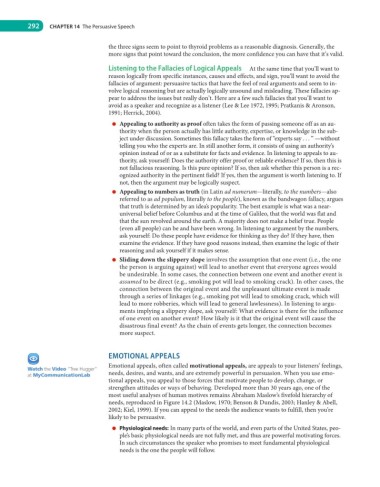Page 313 - Essentials of Human Communication
P. 313
292 ChaPter 14 The Persuasive Speech
the three signs seem to point to thyroid problems as a reasonable diagnosis. Generally, the
more signs that point toward the conclusion, the more confidence you can have that it’s valid.
listening to the Fallacies of logical Appeals At the same time that you’ll want to
reason logically from specific instances, causes and effects, and sign, you’ll want to avoid the
fallacies of argument: persuasive tactics that have the feel of real arguments and seem to in-
volve logical reasoning but are actually logically unsound and misleading. These fallacies ap-
pear to address the issues but really don’t. Here are a few such fallacies that you’ll want to
avoid as a speaker and recognize as a listener (Lee & Lee 1972, 1995; Pratkanis & Aronson,
1991; Herrick, 2004).
● Appealing to authority as proof often takes the form of passing someone off as an au-
thority when the person actually has little authority, expertise, or knowledge in the sub-
ject under discussion. Sometimes this fallacy takes the form of “experts say . . . ” —without
telling you who the experts are. In still another form, it consists of using an authority’s
opinion instead of or as a substitute for facts and evidence. In listening to appeals to au-
thority, ask yourself: Does the authority offer proof or reliable evidence? If so, then this is
not fallacious reasoning. Is this pure opinion? If so, then ask whether this person is a rec-
ognized authority in the pertinent field? If yes, then the argument is worth listening to. If
not, then the argument may be logically suspect.
● Appealing to numbers as truth (in Latin ad numerum—literally, to the numbers—also
referred to as ad populum, literally to the people), known as the bandwagon fallacy, argues
that truth is determined by an idea’s popularity. The best example is what was a near-
universal belief before Columbus and at the time of Galileo, that the world was flat and
that the sun revolved around the earth. A majority does not make a belief true. People
(even all people) can be and have been wrong. In listening to argument by the numbers,
ask yourself: Do these people have evidence for thinking as they do? If they have, then
examine the evidence. If they have good reasons instead, then examine the logic of their
reasoning and ask yourself if it makes sense.
● Sliding down the slippery slope involves the assumption that one event (i.e., the one
the person is arguing against) will lead to another event that everyone agrees would
be undesirable. In some cases, the connection between one event and another event is
assumed to be direct (e.g., smoking pot will lead to smoking crack). In other cases, the
connection between the original event and the unpleasant ultimate event is made
through a series of linkages (e.g., smoking pot will lead to smoking crack, which will
lead to more robberies, which will lead to general lawlessness). In listening to argu-
ments implying a slippery slope, ask yourself: What evidence is there for the influence
of one event on another event? How likely is it that the original event will cause the
disastrous final event? As the chain of events gets longer, the connection becomes
more suspect.
eMOTiOnAl APPeAlS
Emotional appeals, often called motivational appeals, are appeals to your listeners’ feelings,
Watch the Video “Tree Hugger”
at MyCommunicationLab needs, desires, and wants, and are extremely powerful in persuasion. When you use emo-
tional appeals, you appeal to those forces that motivate people to develop, change, or
strengthen attitudes or ways of behaving. Developed more than 30 years ago, one of the
most useful analyses of human motives remains Abraham Maslow’s fivefold hierarchy of
needs, reproduced in Figure 14.2 (Maslow, 1970; Benson & Dundis, 2003; Hanley & Abell,
2002; Kiel, 1999). If you can appeal to the needs the audience wants to fulfill, then you’re
likely to be persuasive.
● Physiological needs: In many parts of the world, and even parts of the United States, peo-
ple’s basic physiological needs are not fully met, and thus are powerful motivating forces.
In such circumstances the speaker who promises to meet fundamental physiological
needs is the one the people will follow.

